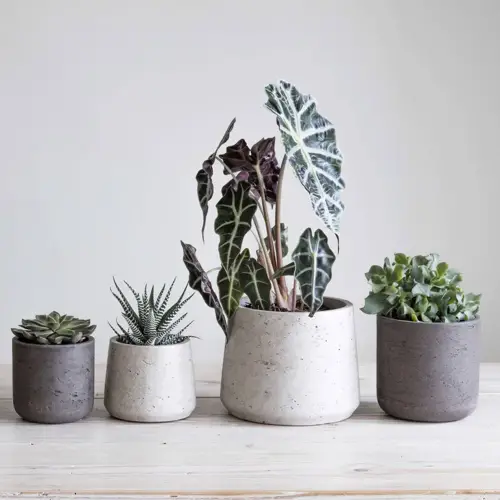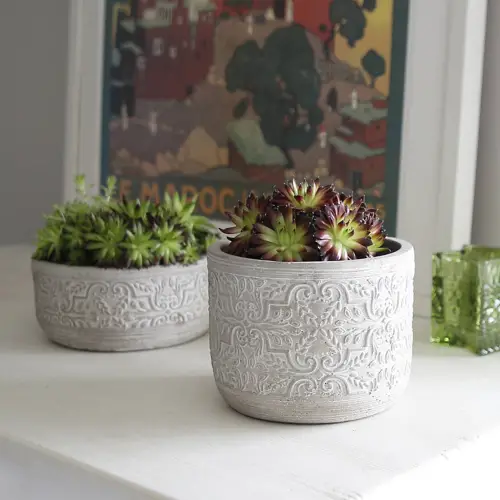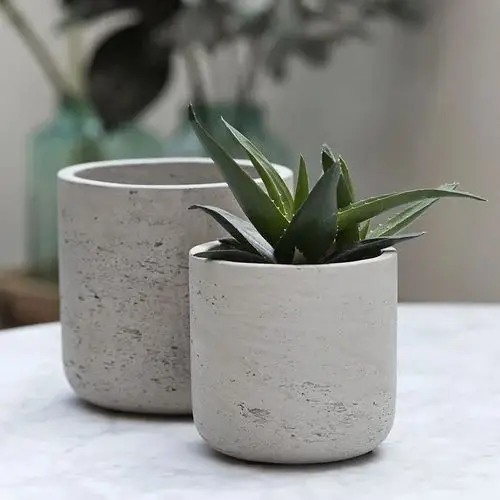Cement pots for plants have become increasingly popular due to their durability and aesthetic appeal. These pots are available in various sizes and shapes, making them a great choice for both indoor and outdoor gardening. However, there are some pros and cons to consider before deciding if cement pots are the right choice for your plants. In this article, we will explore the benefits and drawbacks of using cement pots for plants, alternatives to consider, and tips for choosing the best cement pot for your needs.
What Are Cement Pots for Plants?

Cement pots for plants are containers made from a mixture of cement, sand, and water. This mixture is poured into molds to create an assortment of pot shapes and sizes. The pots are then left to dry, resulting in a sturdy and long-lasting container for plants. Cement pots can be painted or decorated with various finishes to match any indoor or outdoor decor.
Pros of Using Cement Pots for Plants

Durability
Cement pots are incredibly durable, making them an excellent choice for outdoor gardening. They can withstand harsh weather conditions, such as extreme heat or freeze, without cracking or breaking. This durability also ensures that the pot will last for many years, making it a cost-effective option compared to constantly replacing plastic or ceramic pots.
Aesthetically Appealing
Cement pots add a unique and modern touch to any indoor or outdoor space. They come in an array of colors, patterns, and designs, making them easy to match with any decor style. Additionally, they look stunning when paired with plants of various sizes, textures, and colors, creating an eye-catching display.
Heavyweight
The weight of cement pots makes them stable and difficult to tip over, which is particularly important for large or heavy plants. Moreover, this sturdiness prevents the pots from being blown over by strong winds or other weather conditions, ensuring that the plant remains upright and unharmed.
Cons of Using Cement Pots for Plants
Heavyweight
While the weight of cement pots can be an advantage in terms of stability, it can also be a disadvantage when it comes to portability. Cement pots are heavy and difficult to move around, which can be problematic when you need to adjust the plant’s location or reposition it for optimal growth.
Porosity
Cement pots are porous, meaning that they absorb water easily and release it slowly. This moisture retention can lead to overwatering, causing root rot and other problems. To avoid this, it is essential to ensure proper drainage by adding stones or rocks at the bottom of the pot before adding soil.
Breakability
Cement pots can crack if dropped or subjected to significant force, resulting in the pot’s destruction and possible injury. Additionally, if left outdoors during freezing weather, the water inside the pot can expand and cause the pot to crack or shatter.
Alternatives to Cement Pots for Plants
Ceramic Pots
Ceramic pots are durable and come in various colors and designs, making them a beautiful addition to any indoor or outdoor space. They are easier to move around compared to cement pots, but they can still be broken if dropped or exposed to harsh weather conditions.
Plastic Pots
Plastic pots are lightweight and easy to move around. They are also affordable and come in various sizes and designs. They do not absorb water, so they will not promote overwatering, but they might not be as aesthetically pleasing compared to cement pots.
Terracotta Pots
Terracotta pots are traditional and timeless containers for plants. They come in various sizes and shapes and are relatively inexpensive. However, they are porous like cement pots and require proper drainage to avoid overwatering.
Tips for Choosing the Best Cement Pot for Your Needs

Size
When choosing a cement pot for your plant, it is essential to consider the size of the plant’s root system. The pot should be large enough to accommodate the plant’s roots while still leaving space for soil.
Drainage
To avoid overwatering, ensure that the cement pot has proper drainage holes at the bottom. If not, create them by drilling or puncturing holes in the pot.
Finish
Cement pots come in various finishes, including natural, painted, or decorated. Choose the finish that best matches your indoor or outdoor decor.
Conclusion
Cement pots for plants offer numerous advantages, such as durability and aesthetic appeal. However, they also have some drawbacks, such as weight and porosity. Alternatives to cement pots include ceramic, plastic, and terracotta pots. When choosing the best cement pot for your needs, consider the pot’s size, drainage, and finish.
FAQs After the Conclusion
Q1: Can I paint my cement pot?
Yes, you can paint your cement pot using acrylic paints or spray paints. Just make sure to clean thepot thoroughly before painting and use a primer to help the paint adhere.
Q2: How do I clean my cement pot?
To clean your cement pot, use a soft-bristled brush and mild soap or vinegar and water solution. Rinse thoroughly and allow the pot to dry completely before adding soil and plants.
Q3: Can I keep my cement pot outside?
Yes, cement pots are great for outdoor gardening as they can withstand extreme weather conditions. Just make sure to protect them from freezing temperatures by moving them indoors or covering them during winter months.
Q4: How often should I water my plants in a cement pot?
It depends on the plant’s specific watering needs. However, due to the porosity of cement pots, it is essential to check the soil moisture regularly and only water when the soil feels dry to the touch. Overwatering can lead to root rot and other problems.
Q5: How do I prevent my cement pot from cracking?
To prevent your cement pot from cracking, avoid dropping it or subjecting it to significant force. Additionally, protect it from freezing temperatures by moving it indoors or covering it during winter months.
Contact for business
Name: Lucas Trần
Phone number: +84 94 66 555 38
Email: Mr.Lucas@hoangbaominh.com
Profile about Lucas.
Lucas Trần is a seasoned professional with 10 years of experience in the import-export industry. He is the Trading Director of Hoàng Bảo Minh Vietnam and has established strong relationships with major manufacturing workshops in Vietnam. Lucas not only engages in commercial trading but also provides support in sourcing, quality inspection, and collaboration with reputable partners in Vietnam.
With his extensive industry knowledge and wide network, Lucas facilitates successful business transactions and fosters long-term partnerships. His expertise in international trade and commitment to ensuring product quality make him a highly sought-after professional.
For business inquiries or partnership opportunities, please contact Lucas Trần at the provided phone number or email address.
